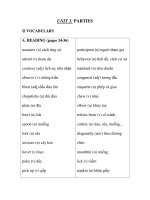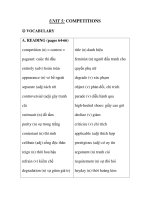Giáo án Tiếng Anh lớp 11: UNIT 11 SOURCES OF ENERGY-SPEAKING ppsx
Bạn đang xem bản rút gọn của tài liệu. Xem và tải ngay bản đầy đủ của tài liệu tại đây (413.87 KB, 12 trang )
UNIT 11 SOURCES OF ENERGY
PART B: Speaking
I. OBJECTIVES:
Aims:
- Getting students to give reasons the of using alternative sources of
energy and talk about the advantages and disadvantages of
alternative sources of energy.
Vocabulary: abundant, enormous, plentiful, renewable, convenient,
polluted, limited, non-renewable, exhausted
Expressions : I think/believe that …
Why do you think so?
I know it is …. However, it is …
Teaching aids: some pictures about the alternative sources of energy
II.PROCEDURE
T
Contents T & S’activities
I). WARM UP: (5 minutes)
.1. Can you tell me some sources of
energy?
2. Which source of energy is the most
popular in Vietnam? Is it clean or
polluted? Is it limited or unlimited? Is it
safe or dangerous?
*Suggested answers
1. fossil fuels, solar energy, wind
energy, water energy, …
2. Fossil fuels are perhaps the most
popular. This kind of energy is polluted
and limited.
II.Check up:Answer the questions:
1.What is major sources of energy?
2.How many sources of energy are
mentioned in the text , and which one
Teacher asks these
questions one after another
and has students discuss
with their partners before
giving answers.
Students may discuss
the questions with their
partners to find out the
answers
-T calls Ss to bb and Ss
answer the questions
Teacher sticks the pictures
do you think has the most potential?
II). PRE-SPEAKING (5 minutes)
1. Wind energy
2. Solar energy Picture A
: Solar energ 3. Geothermal energy
Picture B : Wind energy
5. Nuclear energy Picture
C : Fossil fuel (oil)
4. Fossil fuel (coal)
6. Water gy ener
Picture D : Water energy
Picture E : Fossil fuel (coal)
7. Fossil fuel (oil)
Picture
on the board or shows
them on the projector. Ask
students to match the
following words with each
picture:
Students may discuss the
pictures with their partners
before giving answers
wind energy
Picture B
F : Geothermal energy
Picture G :
Nuclear energ
Picture A:
Solar energy
Picture C
fossil fuel (oil)
Picture E
water energy
Picture D
Picture F
Picture G
geothermal
energy
II). WHILE-SPEAKING: (20 - 25
minutes)
Task 1:The following statements list
some advantages and disadvantages of
various sources of energy .Read and
tick( THE APPROPRIATE BOX a (
nuclear energy
Teacher has students work
in pairs reading the
information in the table
and then discussing the
advantages and
disadvantages. After that,
have some pairs report
their work in front of the
class. The teacher gives
comments if necessary
Students work in pairs and
then report their answers
For advantages) Or D( for
disadvantages ) then compare the result
with a partner’s
.1. Fossil fuels will be exhausted within
a relatively short time.
2. Geothermal heat is available only
in a few places in the world.
3. If the wind does not blow, there is
no wind energy.
4. Water power provides energy
without pollution.
5. A nuclear reactor releases
radiation which is dangerous to the
environment.
6. Solar energy is not only plentiful
and unlimited but also clean and safe.
7. It is expensive to build a dam for
to the class by reading
them aloud.
Teacher should have
students practise speaking
these words first:
T has students read the
example in Task 2 (page
128) then act out and role-
play with one or two
students.
hydroelectricity.
Suggested answer:
1. D 2. D 3. D 4.
A 5. 5. D 6.A 7.
D
Task 2: Talk with your friend about the
advantages and disadvantages of using
each alternative source of energy , using
the suggestion from Task 1
*Useful language
Enormous Dangerous
Plentiful Polluted
Available Exhausted
Unlimited Limited
Renewable Non-renewable
Convenient Unsafe
Students practice in
pairs:
.
Model:
A. I think / believe that wind power can
be an alternative source of energy.
B. Why do you think / believe so?
A. Because our major sources of energy
are running out while the wind is
abundant and unlimited.
B. I know it is also clean and safe to
environment.
However, it is not available when there
is no wind.
A. I think that nuclear power can be an
alternative source of energy.
B. Why do you think so?
A. Because our major sources of energy
are running out while
the nuclear power is unlimited
Teacher should ask
them to pay attention to
the expressions:
Have students work in
pairs practising the
dialogue and changing the
sources and using the
words given to give the
reasons.
B. I know it can provide enough
electricity for the world’s needs for
hundreds of years. However, a nuclear
reactor releases radiation which is
dangerous to the environment
A. I believe that solar energy can be an
alternative source of energy.
B. Why do you believe so?
A. Because our major sources of energy
are running out while the sun releases
large amount of energy every day .
B. I know it is not only plentiful and
infinitive but also clean and safe.
However, it is only possible during the
day time.
A. I think that water power can be an
alternative source of energy.
B. Why do you think so?
A. Because our major sources of energy
are running out while the wind is
unlimited.
B. I know water power provides energy
without pollution. However, it is
expensive to build a dam for
hydroelectricity
A: I think that more and more people
will use the solar energy.
B: Why do you think so?
A: Because it’s available, unlimited and
Teacher has students work
in groups to prepare a
report on which source
they think is the most
potential. Then ask the
representative of some
groups to report to the
class. Give comments and
correct mistakes where
easy to use.
C: But it’s expensive and we can only
have it at specific time of the year.
A: I hope that the progress of science
and technology will help to overcome
this problem.
B: That’s right and then we don’t have
to worry about the shortage of energy.
C: And our life will be more
comfortable with cheap simple devices
run on the solar energy.
I think that …
I believe that …
Why do you think so?
I know it is …. However, it is …
necessary
Task 3:Express your belief on the
increasing use of alternative sources in
the future , Using the ideas from Task 2
.IV). POST SPEAKING: (5 minutes)
Teacher has each students write a
short description of several alternative
sources of energy. Ask some of them to
read their description to the class.
V) Homework.
-do all the exercises again and prepare
the part : Listening









